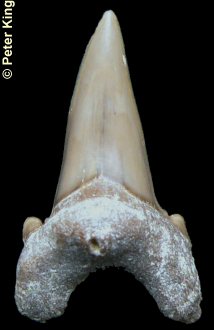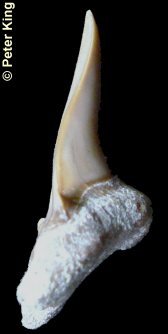 A A |
 B B |
 C C |
|
CARDABIODONTIDS |
The extinct Cardabiodontids are a relatively recently erected Lamniform family, and a mildly controversial one. Cardabiodon has very large tearing teeth with a tall, typically distally curved main cusp with a smooth cutting edge, and variably developed accessory cusps. Root halves are well developed and well separated, with a broad, rounded basal notch.
The family is distinguished from otherwise very similar taxa (Dwardius, Cretoxyrhina, Archaeolamna) largely on the basis of dental formula (arrangement and relative size of the teeth within the jaws), the specifics of which include possession of four upper and lower anterior files, relatively enlarged lower latero-posterior teeth, and distally curved upper anterior teeth. Some workers believe that this distinction warrants lower taxonomic recognition and suggest placing Cardabiodon within a larger family, such as the Otodontids.
Dental formula concepts are of course difficult to apply to isolated teeth, and confident identification of Cardabiodontid material is challenging. There are however certain characters suggested (largely by Siverson, 1999) for distinguishing Cardabiodon from similar large lamniforms. For example, teeth of Dwardius (especially upper anteriors) tend to be less distally curved, whilst those of Archaeolamna tend to be smaller, are more likely to possess well developed accessory cusps. and with a more narrowed main cusp. Cretoxyrhina is perhaps less likely to possess accessory cusps in adults, and with a greater tendency towards a low, wide root with a weakly developed lingual protrusion.
 A A |
 B B |
 C C |
1). Cardabiodon ricki - (A) Labial, (B) lingual, and (C) lateral views of a well preserved upper anterior tooth, one of the few records from the UK (x3.0, Grey Chalk, Bonchurch, Isle of Wight, Pete King Collection). Images © 2009 Pete King, by kind permission.

2). Cardabiodon sp. - Labial view of a typical specimen from the US for comparison (x2.5, Basal Greenhorn Limestone Formation, Upper Cenomanian, Lincoln County, Kansas, Fort Hays State University Sternberg Museum (FHSM) VP-15827). Image © 2009 Michael Everhart (Oceans of Kansas), by kind permission.